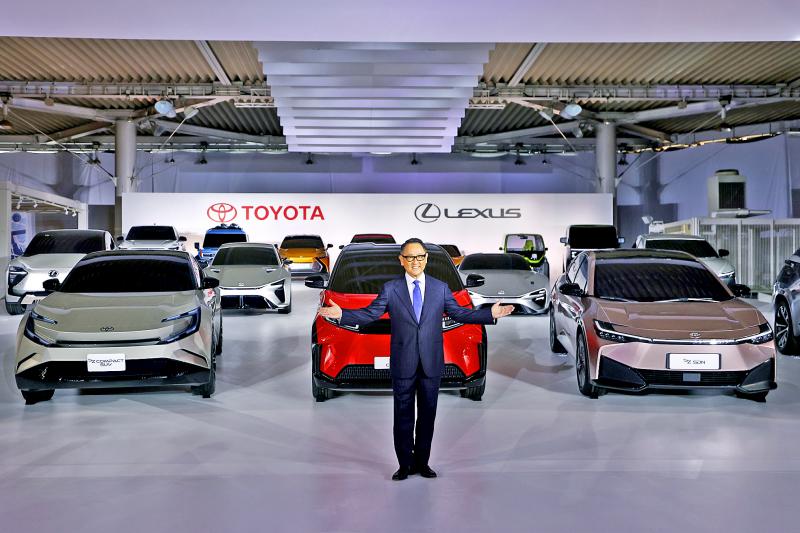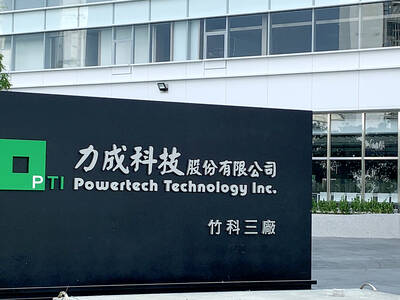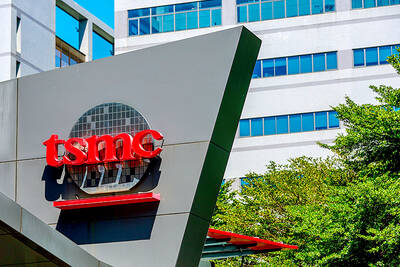The epic fight over who controls the future of the auto industry is about to get a whole lot more interesting.
Tesla Inc, the pioneer and pacesetter, has dominated the early rounds of the new-energy age, capturing investors’ imaginations with a vision for what the next generation of vehicles looks like and seizing the nascent market for fully electric vehicles (EVs).
In the other corner are giants of scale: Volkswagen AG (VW) and Toyota Motor Corp. The world’s two biggest automakers — each sold about 10 or 11 vehicles for every one Tesla did last year — realize the age of the battery-powered vehicle is here and are gaming out how to stay on top.

Photo: Bloomberg
Within five days of one another last month, these masters of mass production laid out plans to splurge US$170 billion over the coming years to preserve their claim on an industry they have dominated for decades.
After a year of standout growth during which Tesla became far and away the most valuable automaker ever, the trillion-dollar question is whether Tesla chief executive Elon Musk’s advantages heading into the next generation of automaking are as insurmountable as his company’s market capitalization suggests.
“When the two biggest car companies in the world decide to go all-in on electric, then there’s no longer a question of speculation — the mainstream is going electric,” said Andy Palmer, the former chief of Aston Martin and ex-Nissan Motor Co executive often referred to as “the godfather of EVs” after being instrumental in developing the Japanese automaker’s battery-powered Leaf. “I expect the shift to electric to be faster than everyone expects.”
The ways VW and Toyota have moved to defend their ground are as different as one would expect from proud German and Japanese titans of industry. One is coming out swinging, putting Tesla squarely in its sights and the other is investing heavily in EVs while continuing to spread its bets, biding time as the early stages of the revolution shake out.
The behemoth doing the furious slugging to take on Musk is VW, which has grown over 84 years into a stable of a dozen brands, manufacturing in about 120 locations around the world and employing more people than the population of Detroit. VW Group generates about US$280 billion a year churning out models ranging from the Tiguan and Passat bearing its namesake badge, to Lamborghini supercars and Scania heavy trucks.
Every year that chief executive officer Herbert Diess has been at the helm, VW has announced unrivaled budgets for electrification. On Dec. 9, he delivered his largest plan yet, allocating 89 billion euros (US$101 billion) to EV and software development over the next half decade.
Diess constantly uses Musk as a measuring stick, so much so that he has acknowledged annoying some within VW’s ranks. In October last year, he welcomed Musk as a surprise guest at an executive conference with 200 of the automaker’s top managers.
VW’s initial foray into EVs was with luxury models such as the Audi e-tron and Porsche Taycan. Last year, it sought to make a splash with more mainstream offerings — the ID.3 hatchback and ID.4 sport utility vehicle (SUV).
Ten months into last year, VW had delivered about 322,000 fully electric vehicles, just more than half of its 600,000 sales goal. Sanford C. Bernstein & Co analysts have assumed VW would sell about 450,000 EVs for the year, which “isn’t the end of the world, but it’s also not quite a reason to celebrate.”
Toyota’s long-standing positioning for the future was on display a couple months ago at a racetrack in the hills of western Japan. While the company brought along its battery-powered bZ4X electric SUV, the car Akio Toyoda took for spins around the circuit was a Corolla Sport H2 Concept vehicle equipped with a hydrogen-fueled engine.
“Heading into uncertainty, what we need are diverse solutions,” the grandson of Toyota’s founder told a news conference on Nov. 13. “We don’t want to tie ourselves to just one option.”
Diversity is one thing; absence is another. The hybrid-powertrain trailblazer known for the Prius has acknowledged being “a little bit late” to fully electric models — and that was four years ago. Toyota’s first mass-market global EV is not set to debut until the middle of this year.
However, weeks after taking hot laps in a hydrogen car, Toyoda traded his racing overalls for a suit and tie, and gave outsiders an unprecedented look at a bevy of future products. When the first curtain was unveiled at a media briefing on an artificial island in Tokyo Bay, there were five EVs flanking him.
Toyoda delivered a brief sales pitch for each vehicle, then raised his palms to the skies before another curtain revealed 11 more battery-electric models.
“Welcome to our showroom of the future,” he said, announcing plans to roll out 30 EVs by the end of the decade.
Of the ¥8 trillion (US$70 billion) Toyota dedicates to electrification in that span, half is to go to fully electric models. The automaker is aiming to sell 3.5 million EVs annually by the end of the decade, almost double a target set just seven months earlier.
It took some prodding for Toyota to get to this point. With cautious comments from executives running against the industry’s general enthusiasm for EVs, some investors and environmental groups criticized the automaker for dragging its feet.
Last summer, Anders Schelde, the chief investment officer of Danish pension firm AkademikerPension, which holds Toyota shares, said he did not see management’s attitudes toward EVs as a winning strategy for the long term.
Schelde said his fund was beginning to look more broadly at its investments to make sure they align with the goals of the Paris Agreement, which established a framework to limit global warming to well below 2°C.
“Toyota has two or three years to clean up their act,” he said in an interview.
Tesla is doing some scaling of its own, too. As the company closed a year in which it delivered more than 936,000 vehicles — up almost 90 percent — it plotted out an investment of as much as 1.2 billion yuan (US$188 million) in its two-year-old Shanghai plant to upgrade equipment and take production beyond its stated capacity of 450,000 units a year. It would add another 4,000 workers at the facility, bringing the total to about 19,000.
Two new assembly plants — one outside Berlin and the other in Austin, Texas — are also gearing up to start making Model Ys.
There’s plenty of demand to meet all this additional output. Wait times on the Model 3 and Y have stretched to more than six months, Tesla investor relations chief Martin Viecha recently told a Deutsche Bank AG conference.
“With market demand for EVs clearly outstripping industry’s ability to produce, success in EVs is no longer about the order book, but rather about production capacity, ability to secure supply, and best cost, where Tesla feels it has considerable lead,” Deutsche Bank analyst Emmanuel Rosner said in a note.
Others see Tesla being toppled from the electric vehicle throne as new entrants muscle into the growing market.
IHS Markit projects Tesla’s EV market share in the US would fall to 20 percent by 2025, from slightly more than 50 percent today.
Heavy investment “will put Toyota and Volkswagen in a better position to compete with EV specialists,” said Anna-Marie Baisden, head of autos research at Fitch Solutions. “We have long held the view that the more traditional carmakers will have certain advantages over startups such as scale, manufacturing experience and brand loyalty.”

The DBS Foundation yesterday announced the launch of two flagship programs, “Silver Motion” and “Happier Caregiver, Healthier Seniors,” in partnership with CCILU Ltd, Hondao Senior Citizens’ Welfare Foundation and the Garden of Hope Foundation to help Taiwan face the challenges of a rapidly aging population. The foundation said it would invest S$4.91 million (US$3.8 million) over three years to foster inclusion and resilience in an aging society. “Aging may bring challenges, but it also brings opportunities. With many Asian markets rapidly becoming super-aged, the DBS Foundation is working with a regional ecosystem of like-minded partners across the private, public and people sectors

BREAKTHROUGH TECH: Powertech expects its fan-out PLP system to become mainstream, saying it can offer three-times greater production throughput Chip packaging service provider Powertech Technology Inc (力成科技) plans to more than double its capital expenditures next year to more than NT$40 billion (US$1.31 billion) as demand for its new panel-level packaging (PLP) technology, primarily used in chips for artificial intelligence (AI) applications, has greatly exceeded what it can supply. A significant portion of the budget, about US$1 billion, would be earmarked for fan-out PLP technology, Powertech told investors yesterday. Its heavy investment in fan-out PLP technology over the past 10 years is expected to bear fruit in 2027 after the technology enters volume production, it said, adding that the tech would

Taiwan Semiconductor Manufacturing Co (TSMC, 台積電) has secured three construction permits for its plan to build a state-of-the-art A14 wafer fab in Taichung, and is likely to start construction soon, the Central Taiwan Science Park Bureau said yesterday. Speaking with CNA, Wang Chun-chieh (王俊傑), deputy director general of the science park bureau, said the world’s largest contract chipmaker has received three construction permits — one to build a fab to roll out sophisticated chips, another to build a central utility plant to provide water and electricity for the facility and the other to build three office buildings. With the three permits, TSMC

YEAR-END BOOST: The holiday shopping season in the US and Europe, combined with rising demand for AI applications, is expected to drive exports to a new high, the NDC said Taiwan’s business climate monitor improved last month, transitioning from steady growth for the first time in five months, as robust global demand for artificial intelligence (AI) products and new iPhone shipments boosted exports and corporate sales, the National Development Council (NDC) said yesterday. The council uses a five-color system to measure the nation’s economic state, with “green” indicating steady growth, “red” suggesting a boom and “blue” reflecting a recession. “Yellow-red” and “yellow-blue” suggest a transition to a stronger or weaker condition. The total score of the monitor’s composite index rose to 35 points from a revised 31 in August, ending a four-month